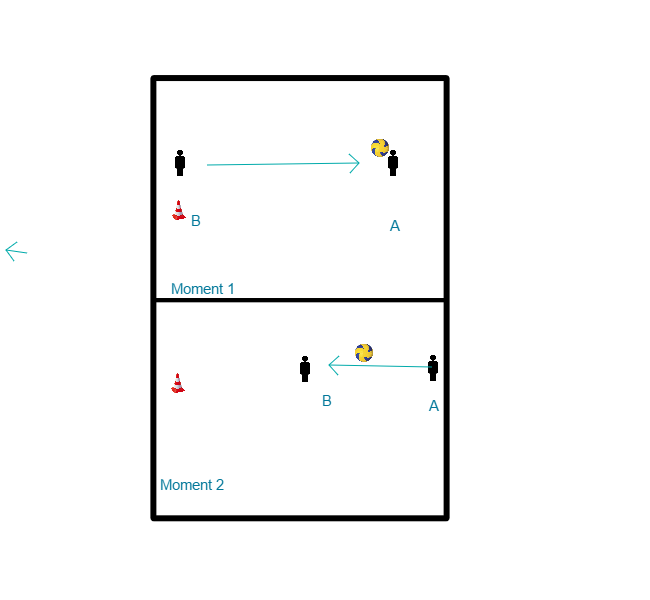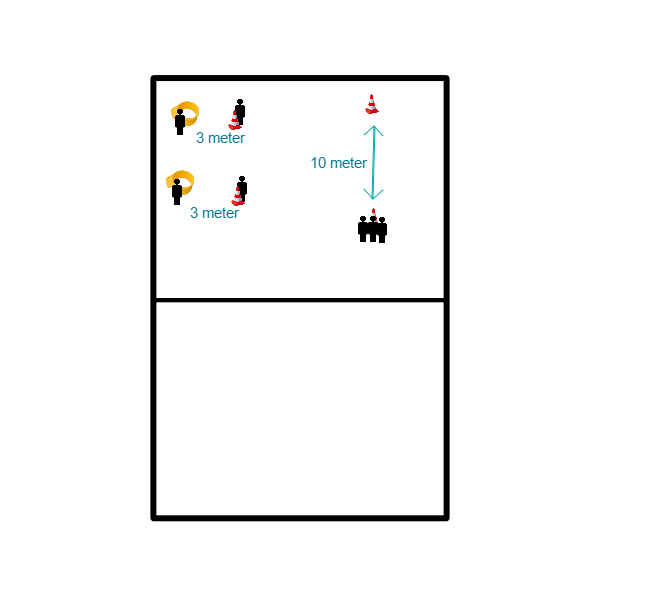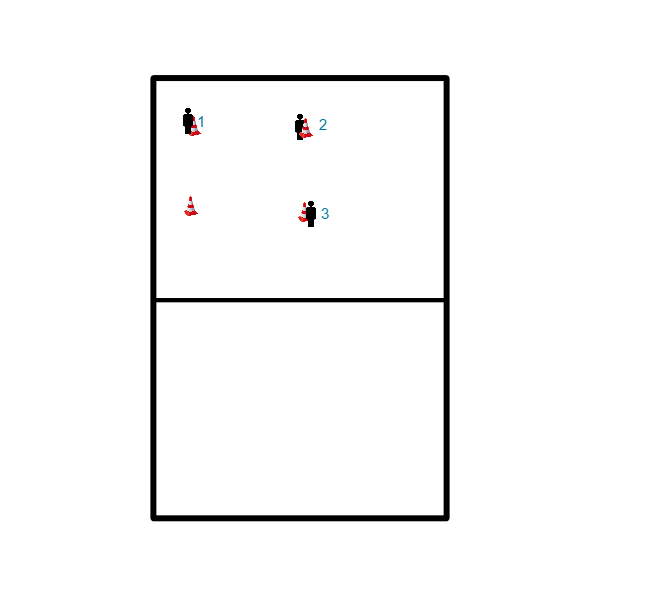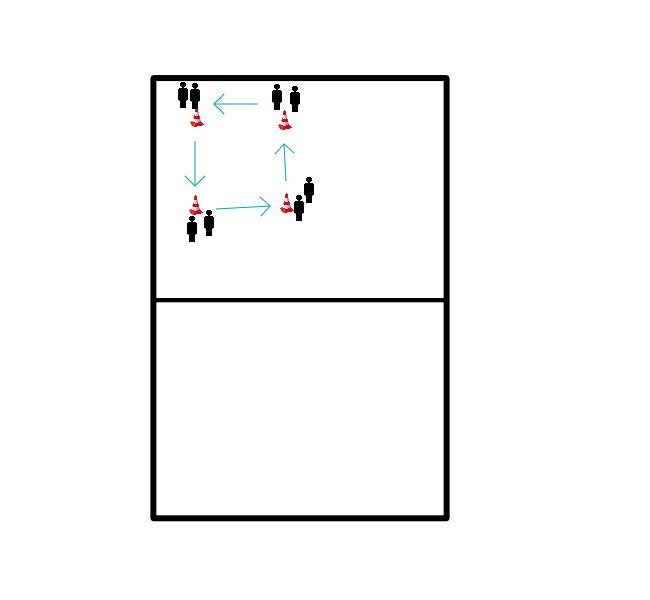Korfball drills
Inshort: practise various forms of walking, stopping, turning and jumping while running.
Organisation:lay out a 'course'onthe field (with pawns or baskets in a large circle). In the hall we just walk around. A whistle is very handy, especially on the field.
Walk around in a quiet pace, spreading the group out over the entire course. The space thus created must be maintained as much as possible during the entire exercise. At the sign of the trainer turn quickly and walk in the other direction.
The same, but now turn the other way. The first steps after the turn are done with a small sprint (short steps).
Walk backwards. At the sign of the trainer turn around again and walk backwards in the other direction. Alternately turn both ways.
Walk around with cross passes. Also the other way around.
Run around. At sign of the coach quickly sit (or lie down), stand up again, make a short sprint and continue running.
Tempo slightly higher than run. When the whistle is blown once, then a sprint is made. If the whistle is blown twice in quick succession, run backwards a few metres. Be careful, collisions can happen!
Run around. When the whistle blows, try to touch the person in front of you. After a maximum of 20 metres, continue sprinting at the same pace.
The players walk closer to each other, the distance between them is about 1,5 meter. At the sign of the trainer the last one in the row sprints to the front, zigzagging around the others. The trainer whistles every 2 or 3 seconds. Can you catch up with the person in front of you?
At the sign of the trainer the players make a high jump. Left and right turn in turn.
As i., but now the arms must also be raised when jumping up, like when catching a ball under the basket. Make sure you keep jumping high!
The players go round on their right leg, limping. After about half a minute, limping on the left leg.
Like k., but now the jumps must be made as big as possible. Try to get around in as little jumps as possible!
The players may alternate between limping on the left and on the right leg a few times. The players are numbered, alternately 1 and 2. The numbers 1 stand up. The numbers 2 jump over the numbers 1 until they are back on their own place. Then the other way around.
At the sign of the trainer, the players bend their knees and jump up high (push off with two legs, swinging their arms up as support).
Organisation: The players all line up on one side of the pitch.
Before starting these exercises, first perform a good warming-up (see above) with stretching exercises. The sequence was demonstrated by Margriet Poiesz (who is both an athletics and korfball coach) during one of the in-service training sessions of the North district of the NKTV
Steigerungen: running to the other side, whereby the pace is gradually increased to near-sprint speed
Skipping: a form of knee lifting at a very high tempo. The torso is in running position and is certainly not hanging back. The feet are reaching for the ground. This exercise focuses on the front swing phase.
Heels / buttocks or heel strike in high tempo (exercise for the back swing phase). The knees hang down, the trunk is in the walking position
Walk to the other side with long jumps (exercise for the back swing phase). Pay attention to a powerful, long push off. In this exercise, the feet also touch the ground, as it were.
simple running exercises for warming up, in which concentration and reaction also play an important role. Organisation: Pairs in an empty, marked out space.
Walk behind each other in a steady pace, criss-crossing the whole room. Number 2 follows every movement of number 1 as fast as possible, keeping about 1 metre distance. After a while change.
As a., but now the front runner tries to lose the back runner by sudden feints and/or tempo changes.
As a., but now other movements are also allowed: cross passes, jumping, lying down quickly and getting up again, etc.
Variations:
- Perform the same exercises with music
- Do the same exercises in groups of three or four. In this form, 'comical' situations will certainly occur now and then. It doesn't have much to do with korfball then.
- No more pairs: everyone walks freely through each other. The players walk towards each other, feint and then pass to the left.
- Like d., but now passing on the right
- Like d., but now they turn around each other and walk back.
- Special exercise for getting used to the hall: walk criss-cross through the whole hall, but not touching any line. Especially in halls with a lot of lines on the floor this is a good and fun exercise to get the 'contact with the hall' back in the legs.
- Like g., but now keep walking on the lines.
With 3 players at the basket, 1 attacker with the ball under the basket and 2 players who shoot the ball in motion (minimum distance 5 meters
). The attacker who is first to score 3 goals may remain in front of the basket and the attacker who has lost the game must take the place of the attacker.
You make a square, in it stands an attacker, the attacker must keep moving in the square while a defender walks by. One person always plays the ball. The defender looks at the ball and tries to catch it. Every time the attacker catches the ball, someone else runs into the box. When the defender catches the ball, he throws it back and you try again.
 2 teams. Per pair 1 ball and 1 pawn. Player A stays on his spot. Player B starts with the pawn, which is about 10 meters away. Player B runs to player A. Player A throws (with 1 hand) the ball to player B. Player B keeps running until he has caught the ball and then stops. B throws the ball back and runs to the pawn to start the exercise again. after 10x change.
2 teams. Per pair 1 ball and 1 pawn. Player A stays on his spot. Player B starts with the pawn, which is about 10 meters away. Player B runs to player A. Player A throws (with 1 hand) the ball to player B. Player B keeps running until he has caught the ball and then stops. B throws the ball back and runs to the pawn to start the exercise again. after 10x change.
The whole group walks a circle around the yellow lines in the middle in a line. When the trainer calls 'yes', the person at the back of the line starts running as fast as possible. The children do this by pulling a sprint.
Options:
The children run after each other around the yellow lines in a line. The person at the front of the line can do whatever he wants for example: heels buttocks, sprints, lifts his knees etc. Whenthe trainer calls 'yes' the person at the back of the line starts to run as fast as possible and can choose what he wants to do. It must be something other than normal running/jogging, it may be sprinting.
Children will be divided among the poles, up to three children per pole.
Pole:
Two children stay by the pole. You have a declarator and a shooter, the shooter stands near the pawn at about 3 metres distance.
The shooter has to score 4 times and then there is a rotation.
Pawns:
There are two pawns facing each other at a distance of 10 meters. The other children stand near the pawn and run back and forth. When 4 times are scored by the shooter, there is a rotation.
Rotation:
The shooter becomes the runner.
The runner becomes a catcher.
The catcher becomes the shooter.
Variation:
The distance increases from the shooter.
The runner's distance increases.
Walk-throughs, short chance, penalty throw, etc. are taken.
 In short:
In short:
A trio has to pass the ball to each other in a square.That's tricky yes, because one is always missing....
Organisation:
Three players stand in an imaginary square about eight metres from each other. One corner remains unoccupied. The middle player (number 2) of the three has the ball.
You put four pawns in a square with a distance of 8 metres. Then you let the children make pairs. The children may take turns rolling the dice. You have three different rounds:
Round 1:
The children roll the dice. For example, if a group throws 4, each group must run 4 laps around the pawns.
Round 2:
The children first say who they are going to roll the dice for and then they get to roll passes. So they pick a group, say group 2 and roll the dice for that group.
Round 3:
The children first get to roll the dice and then they pick a group. This is almost always the most fun round. 
You put up three poles in a triangle, in the middle of the three poles you put a pawn. Three children are placed as attackers and the other children stand near the pawns.
First, you can choose that the attackers have to run through the poles. It doesn't matter which pole they hit, they can hit the same pole twice in a row. You can choose for this, so they have to run a lot. Also the children have to score 2 times, the person who scores first can trade with a declarator, the other children can trade with a declarator.
After that you can choose to letthe children do free balls, penalty throws, foul balls etc.
Everyone lies down on the floor like a plank, supporting themselves on their elbows with their legs extended. Then the children jump up and stretch all the way.








